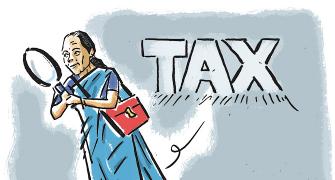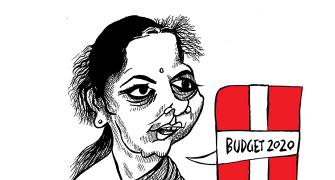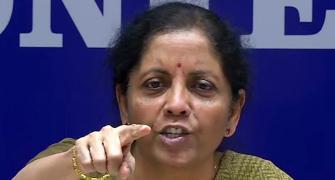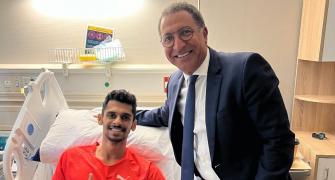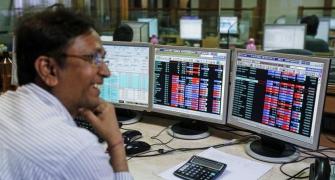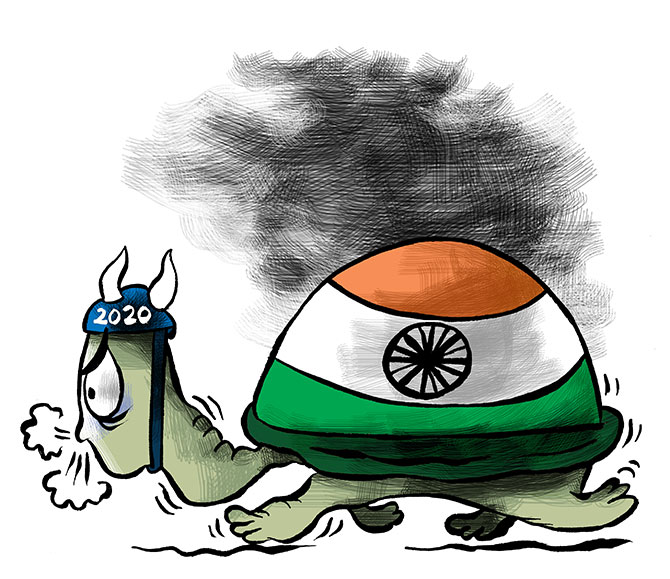'The slide in growth has arisen primarily because we have an NBFC crisis on top of a banking crisis,' points out T T Ram Mohan.
Illustration: Uttam Ghosh/Rediff.com

Rating agency Standard & Poor's has served India an ultimatum: Improve gross domestic product growth or face a downgrade.
Moody's has changed the outlook on the rating from 'stable' to 'negative'.
S&P forecasts growth of 5.1 per cent in 2019-20.
Moody's pegs growth at 4.9 per cent.
Who would have thought even a couple of years ago that India's GDP growth would fall below 6 per cent?
The agencies can't be faulted for warning of a possible downgrade.
The flow of news has been pretty grim.
The Index of Industrial Production was down 3.8 per cent in October over last year.
Consumer Price Index inflation rose to 5.5 per cent year-on-year in November.
The fiscal deficit for FY 2019-2020 is certain to end up higher than the target of 3.3 per cent of GDP.
Distress in the financial sector continues.
Credit offtake is down.
Where the agencies are wrong is in the rating they have given India even in good times.
The Economic Survey of 2016-2017 argued convincingly that India deserved better than the BBB rating that S&P gave it when the economy was doing a lot better.
A country's rating must relate primarily to its capacity and willingness to service debt.
India has not defaulted on its debt obligations over the years.
Its debt-to-GDP ratio of around 65 per cent may seem on the higher side.
But it must be viewed in conjunction with its ratio of external debt to GDP and its growth rate.
Do foreign lenders think there is a danger today of India not meeting its debt obligations because our growth rate has slipped? The suggestion seems laughable.
Well, the rating agencies are not going to go away and a downgrade is always a headache.
So the challenge for India is to ensure a return to a higher growth rate.
A fiscal stimulus (from the present level of deficit) seems impossible.
There is talk of rapid-fire strategic sale of public sector unit (PSU) assets to raise revenues.
This is easier said than done.
Strategic sales must go through a rigorous process of valuation and bidding -- and they are not free from controversy even then.
The sale of Air India, which failed in 2018, is still on with successive deadlines having been missed.
Monetary easing is off the table after the December pause by the Monetary Policy Committee.
This is not a big issue at the moment.
Transmission of much of the 135 basis point cut that has happened thus far is more important.
Stickiness in deposits is, of course, a factor hindering transmission.
Other factors may be at work.
Public sector banks may be reluctant to lend because many operate at close to the minimum capital requirement.
Thirteen PSBs are going through the enormous task of merger.
This may have slowed down credit decisions.
Thus, the two major macroeconomic tools for reviving the economy, fiscal and monetary stimulus, are blunted.
The government is, therefore, right in focusing on addressing issues at the sectoral level.
Relieving stress in the financial sector must be the priority.
In banking, there have been two pieces of good news.
One, the ArcelorMittal takeover of Essar Steel is going through and banks are due to receive Rs 42,000 crore.
Banks with exposure to Essar Steel can expect to write back the provisions they have made.
Two, banks have recovered Rs 6,000 crore through the sale of Prayagraj Power Generation Company to an entity owned by the Tata Group, the ICICI Bank group and global investors.
Creditors had to take a 52 per cent haircut for the deal to go through in a one-time settlement.
It is striking that the deal is financed by State Bank of India, which is among the banks that have taken a haircut.
If bankers finally feel emboldened to attempt resolution of large stressed assets outside the bankruptcy process, it is great news.
The prime minister has sent the right signals: He has said that bankers' legitimate business decisions would not be questioned.
The Alternative Investment Fund (AIF) of Rs 25,000 crore for completion of projects in affordable and middle-income housing has got going.
Around Rs 10,000 crore has been raised for the AIF.
The scheme for partial credit guarantee for banks buying assets of NBFCs has also taken off.
The government has cleared proposals for Rs 7,657 crore under the scheme for which the budgeted amount is Rs 1 trillion.
The partial credit guarantee available under the scheme has been extended to NBFCs with a BBB rating. (Earlier, it was available only for NBFCs with a rating of AA or above).
The two schemes should help but only at the margin.
The amount allocated for the AIF is quite small.
Operationalising the scheme is not easy.
The partial credit guarantee will not induce banks to go out and grab NBFC assets.
Banks will be leery of a big chunk, which is unsecured consumer loans.
Real estate loans are a mixed bag comprising residential housing loans, lease rental discounts, commercial premises, developer finance, etc.
Banks would be interested in the first two.
But they already have enough demand for these two products on their account.
They may not feel the need to buy these assets from NBFCs.
The slide in growth has arisen primarily because we have an NBFC crisis on top of a banking crisis.
Getting the NBFC sector back on its feet is going to be a long drawn-out affair.
The focus must be on banks picking up the slack.
Infusing adequate capital into public sector banks, ensuring top slots are filled speedily and empowering management to resolve stressed assets hold the key to a faster recovery.
T T Ram Mohan is a professor at IIM Ahmedabad.


